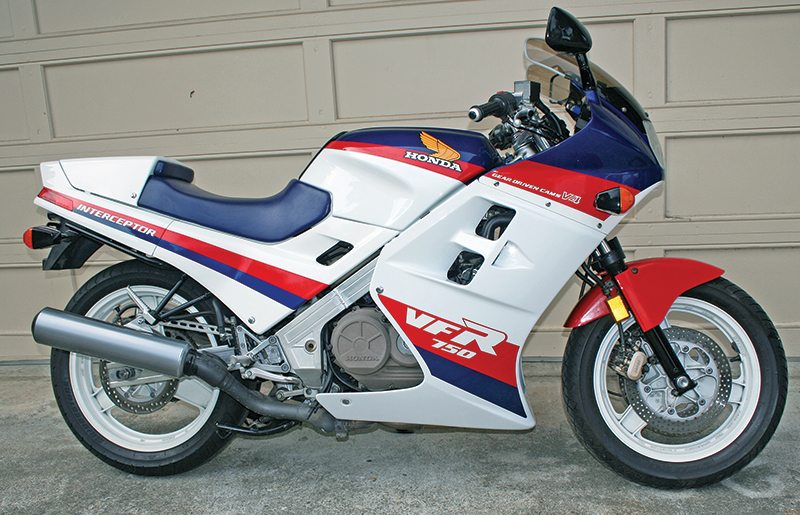
The motorcycling world was immensely impressed when Soichiro Honda introduced the CB750 in-line four in 1969, but by 1980 the copycats had relegated the concept to the initials UJM—Universal Japanese Motorcycle. However, the fertile mind of Mr. Honda had more ideas, and he felt that a V-4 would be the ideal sporting engine. Clean sheet of paper, a few million yen, total secrecy…and the project zoomed ahead.
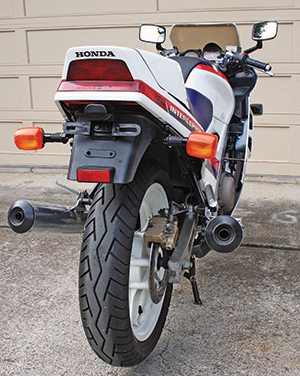
Occasionally even a reputable company like Honda can screw up—which it did with its first high-performance V-4. The VF750F Interceptor was introduced late in 1982, the motorcycling world was again agog…but when the beast was thoroughly thrashed things went wrong with the top end, notably inadequately oiled camshafts and their bearings. Of course Honda fixed the problems, at great financial expense, as well as expense to the company’s reputation. Sales slumped.
The backroom boys at Honda got to work on redoing the Interceptor. They were going to build a V-4 that would win customer confidence back…no matter how much it cost. For 1986, the VF became the VFR, and about the only connection between the two was the bore and stroke, 70 x 46.8mm. The parts fiches were entirely different.
Most notable was the styling; whereas the VF had looked very race-tracky, the VFR appeared more street-oriented, even with the sporty full fairing. Honda had decided to set the roadsters very apart from the racers, like the factory’s RVF, as the money was in selling to the public, not the extravagantly expensive race bikes.
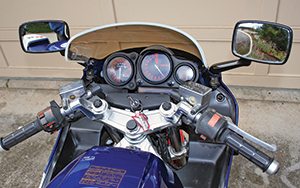
The roadster had some racy mods, like changing the cam drive from chain to gear—at about four times the cost. The cam chains on the VF had stretched a bit too easily, and this new gear layout involving eight gears in the middle of the engine, was advertised on the fairing. An even more basic change was with the crankshaft, using a 180-degree layout rather than the previous 360, allowing for changes in the heads that permitted larger carburetors—36mm instead of 34.
A lot of general Jenny Craig-work went on, the end result being that the VFR engine weighed about 10-percent less than the VF’s, and redline had been moved up 500 rpm from 10,500 to an astonishing 11,000. With a large increase in horsepower—22 said the press releases! Those were factory claims, taken at the crankshaft, or maybe piston dome. One magazine that tested both bikes produced a rear-wheel reading for the VF of 77 horsepower, the VFR, 82. Dynos generally do not lie.
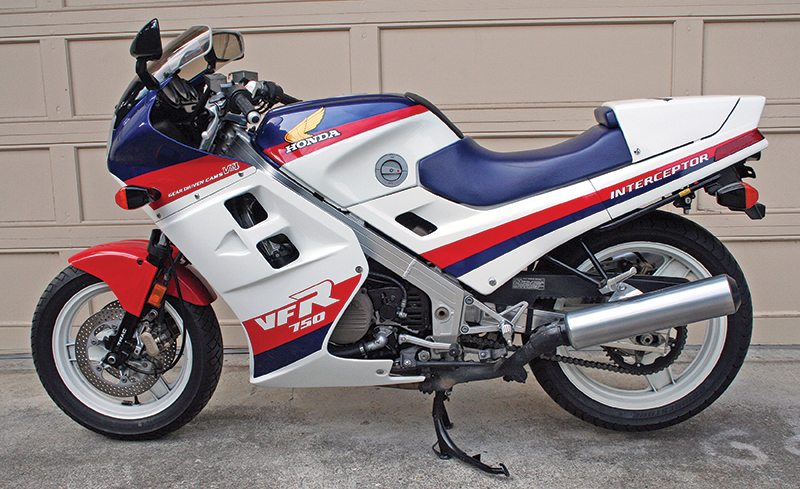
The chassis was a sport rider’s delight. The aluminum twin-spar frame weighed just a tad over 30 pounds, and had enough flex to keep both the street rider and track-day enthusiast happy. The engineers had shaved, shaved, shaved away, right down to aluminum footpegs, and the VFR weighed in at 44 pounds less than the VF. Half an inch had been taken off the wheelbase too, now down to 58.1 inches. Speaking of wheels, the VFR retained the 16-inch front, 18-inch rear of the VF. The Showa 37mm fork was air-adjustable and had 27.5 degrees of rake, 4.3 inches of trail. The Pro-Link single shock was good, but certainly not top quality, and offered only preload adjustment. The five-gallon tank allowed 170 miles between fill-ups.

All this could be had for a rather pricey (compared to other 750s) $5,300—add another four grand if you wanted the race kit, which included very trick titanium valves. But the stocker could turn a quarter-mile in under 11 seconds.
Then the VFR750F Interceptor did not appear on showroom floors in the U.S. for the next three years due to the Harley-imposed 700cc tariff, though a 699cc version did stay on through 1987. In 1988, Europe got the track-worthy RC30, a.k.a. VFR750R, though it was not imported here until 1990.
Which also brought about the second iteration of the VFR750F—without the Interceptor name. Insurance companies were penalizing riders who had the audacity to own machines with names like Interceptor and Hurricane, so Honda merely left them off the fairing. This new VFR came with a revised chassis using a single-sided swingarm, compliments of the French company ELF (Essence & Lubrifiants de France), which specialized in new frame designs. The front fork had been enlarged to 41mm, using cartridge dampers, with a 26-degree rake, trail of 3.9 inches. And 17-inch wheels. It weighed 30 pounds more, as well. But remember, this was a roadster, not a racer.
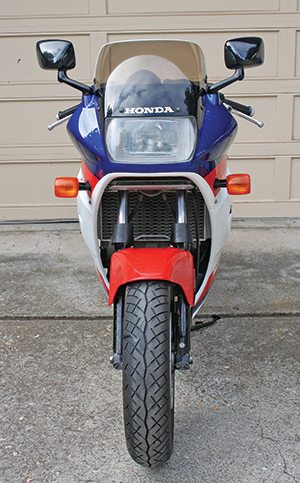
Buyers were happy. Sales were satisfactory. But customers are always looking for something new, or new-ish. For 1994, the VFR750F got a stem-to-stern redesign, with NR750-influenced styling, less weight, more power, a larger 5.5-gallon gas tank, and new paint—all red, with black belly pan and black wheels. The colors stayed the same for the next three years. Prices were now competitive, with the VFR going for $8,200, the similar Kawasaki ZX-7 and Suzuki GSX-R750, $8,100.
If one were serious about winning on the track, an RC30 cost $15,000, twice the price of the VFR. Add another 10 grand for the very serious go-fast parts.
But enough of this 750 nonsense. The VFR was a sportsman’s motorcycle, good for the road and the occasional track day, not for racing. So why leave it at 750? For 1998, the engine was enlarged to 781cc and it was called the VFR800FI, the “I” standing for fuel injection. And the Interceptor name returned, after it had gone missing for many years.
(This Retrospective article was published in the April 2014 issue of Rider magazine.)








I too owned one of these bikes (699cc) gear driven cams. It was actually my first bike that was my only source of transportation for 3 years… It was awesome – I was in my early 20’s living in Seal Beach, CA.
Fun dependable ride…. Thanks for posting all this info – really brings back memories.
Mike
My 1986 Vfr750f did 91hp completely stock on Dr. Dyno’s Dyno in Connecticut on a 92 degree day and now with a Yosh/akrapovic carbon can with a K&N filter airbox mod and 147.50 mains did 101.6 on dyno !! Wheel conversion and other mods to lighten does allow it to run along @ 155mph and verified it with GPS.My whole point is your stock hp number is very low have seen as a general they do between 89-91 stock…Other than that good article…RL
I ran mine up to 155 mph coming back from LA , was signing good I was 300 extra rpm into red zone.
86vfr750f full Yosimura 4 into 2 into 1, 3/4 race baffle, stage 2 jet kit, modded airbox K&N filter, and if I remember correctly I had 2 extra teeth on the rear sprocket.
Miss that bike.
Don’t forget the 0 to 60mph in only 2.3 the 1986 VFR recorded….that is fast by even todays standards it had the perfect power to weight ratio to launch and not spin or wheelie to hard.